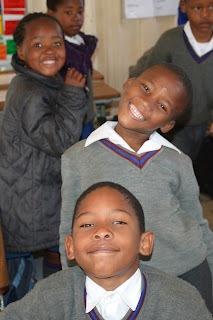There are a million different teaching styles in this world, and and that holds true here in South Africa. One of the main reasons I am here is to interact with other teachers and see how they teach. Our team has been here for three weeks and that has given me quite a few opportunities to see how they do it here!
This week I divided up my time at Emafini between two first grade classrooms. To date, I have visited with one fourth grade classroom and four first grade classrooms.
So the big question is... what have I observed?
Where to begin?! First of all, there is no grade level Kindergarten, so learners in first grade are essentially Kindergartners. I had brought various lesson plans along, activities and books, and was not able to use most of them. Not just because the learning level was lower, but because of the language barrier. That is another large difference here. (Huge, in fact!) Before coming here, we were told the children spoke in their native tongue. But that did not really hit me until I was in the classrooms listening to the teachers and students speak Xhosa. (It definitely gives me a new perspective on ESL learners.)
 |
| She said "Welcome Teacher Lara! Call me Popo." |
Luckily for me, the teachers know English fairly well, and they have been teaching their learners some English throughout this school year. As I helped the teacher, I found myself being very quiet and pointing at children's papers to get my point across.
Music and movement is used more often than the classrooms I have been in in the US. I think we tend to associate music and movement with younger children, more in the preschool classrooms. As our students move up through the grades, the music and movement is not as common. In three of the classrooms I've been in, the teacher and students loved showing what they can sing! I would be treated to song after song, all in Xhosa. Sometimes they would also sing it in English - then they would quiet a bit and listen to me to sing to verify the words.
I was astounded at how many children are squeezed into a classroom!
 |
| There are 31 learners in this "container". |
I used to grumble about 23 students. Here, a classroom half the size of mine holds 30+ learners. Desks are lined from wall to wall with just enough room to wiggle into a chair. Not all children have their own desk - many share desks. They are more of a table since there is no storage space inside. Personal items stay in their backpacks and hang on the backs of their chairs. Most classrooms had no place for children to gather on a main carpet unless they moved desks out of the way and put down carpet squares (One class did this!)
Just as space is limited, so are supplies. Teachers are given chalk, and students are given math, Xhosa, and English workbooks, plus a composition book. Teachers follow the lessons in these workbooks- there you have it, instant lesson plans; I found that to be a surprising difference.
 |
| She is lucky- she has a pencil sharpener. |
Crayons are rarely used, pencils are like gold, and sharpeners are even more scarce.I was sad to see students with stubby, chewed on pencils. I finally came to realize it is part of teaching them responsibility and caring for what their family buys them. If a child has a pencil pouch it contains a small pencil sharpened on both ends and maybe a bit of eraser. If children do not have a pencil, they wait their turn to share a pencil. If the lead breaks, a few lucky children pull out a small sharpener and stand by the trash bin to sharpen it. Compare that with what we see in our students' pencil boxes...
For wall displays, there were numerous teaching posters on the wall, in both English and Xhosa, so even though the rooms are small, they are colorful! Another huge difference is that there is no internet (thieves have stolen the wiring so often it will not be replaced) and none of the classrooms had any form of a computer. That would definitely cramp my teaching style! But these teachers use what manipulatives they have and depend more on verbal explanation to get their ideas across.
 |
| These first graders are sweeping their classroom |
Students here are expected to clean their campus. It is common to see them washing windows and sweeping floors. They also carry the hot lunches to the classrooms. Oh, and there is no heat. Just open a window and keep that fresh air flowing! (Yes, it is winter and it is cold. Everyone just keeps their jackets on.) They are definitely saving money on their electric bill.
 |
| Young men are washing windows |
 |
| This young man is delivering lunch to the first graders. They eat in their room. |
Books were another big difference I noticed. I love literacy and tying books into the lessons I teach. My students have access to my classroom library and I expect them to have one or two books in their desks to read as they finish their work. Literacy here is on a different level. Teachers do read-alouds using the state mandated skill-based readers. Those readers are what make up the classroom library. (There is a library on campus, and when a parent volunteer is there, students can borrow a book.) If I had known how few books were available, I would have traded out the crayons and pencils I brought to share and only brought books!
 |
| Emafini's library with a volunteer librarian |


















































